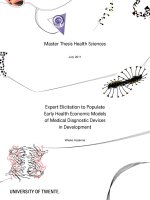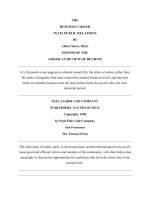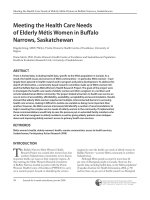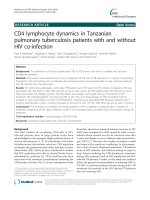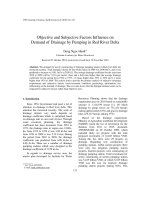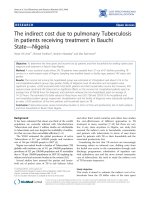The validity of the diagnostic methods in predicting pulmonary tuberculosis potx
Bạn đang xem bản rút gọn của tài liệu. Xem và tải ngay bản đầy đủ của tài liệu tại đây (85.06 KB, 5 trang )
African Journal of Microbiology Research Vol. 4 (8), pp. 613-617, 18 April, 2010
Available online
ISSN 1996-0808 © 2010 Academic Journals
Full Length Research Paper
The validity of the diagnostic methods in predicting
pulmonary tuberculosis
Sulhattin Arslan
1
*, Levent Özdemir
2
, Yeltekin Demirel
3
and Ibrahim Akkurt
1
1
Department of Chest Diseases, Faculty of Medicine, Cumhuriyet University, 58140 Sivas, Turkey.
2
Department of Public Health, Faculty of Medicine, Cumhuriyet University, 58140 Sivas, Turkey.
3
Department of Family Doctor, Faculty of Medicine, Cumhuriyet University, 58140 Sivas, Turkey.
Accepted 12 March, 2010
In our study, we aimed to determine the validity of diagnostic methods for tuberculosis. Eighty-one
people suspected to have tuberculosis were included in the study. The validity of the applied methods
for the diagnosis of tuberculosis tuberculin skin test (TST), sputum smear, and used in diagnostic chest
X-ray findings (CXR), clinical features and history were evaluated as culture was considered the
reference test. Included in the study of 81 people (54 males 27 females) mean age was determined as
45.04 ± 18.69. The most sensitive diagnostic methods were detected as clinical and sputum smears (89
and 86%). The sensitivity of PPD and Radiology have been identified as 0.74 and 0.73 respectively.
Diagnostic method with the highest specificity value was found to be radiology. The positive predictive
values of PPD, radiology, clinical and sputum smear were identified as 98, 94, 96 and 92%, respectively.
PPD had the lowest negative predictive value with 26%. In our study, the validity of the diagnostic
methods for the tuberculosis are compatible with the literature. These methods in the diagnosis of
tuberculosis are still valid. We think our study may add to the current data in the literature about the
topic.
Key words: Validity, specificity, sensitivity, PPD, TST, sputum smear, culture, tuberculosis, clinical features.
INTRODUCTION
Every year, there are 8.8 million new active TB cases and
nearly 2 million TB deaths worldwide, 5,000 every day,
mostly in the poorest communities of the developing
world. One third of the world’s population has latent TB
which may later develop into an active form of the
disease. TB has also become the leading cause of death
among people with HIV. A key challenge for the public
health community is to be able to effectively diagnose
patients so that valuable resources and medicines are not
wasted on misdiagnosis and repeat treatments. The lack
of accurate diagnosis leads to an unacceptable burden of
human suffering and to a waste of precious resources in
poor countries (Diagnostics for tuberculosis [Internet],
cited 2009, December 2). Bacteriological culture,
considered the diagnostic gold standard, can identify the
*Corresponding author. E-mail: Tel:
+90 346 258 00 00/0213, 905326944371. Fax: +90 346 258 13
05.
M. tuberculosis organism in over 80% of TB cases with a
specificity of over 98% (Lee et al., 2003; Roggenkamp et
al., 1999; Idigoras et al., 2000). When present in suffi-
ciently high concentrations, the bacteria can be readily
identified by trained technician using this technique,
which has changed little since it was invented over 100
years ago (Diagnostics for tuberculosis [Internet], cited
2nd December, 2009,).
METHODS
Eighty-one people who were suspected to have tuberculosis were
included in the study. The validity of the applied methods for the
diagnosis of tuberculosis tuberculin skin test (TST), sputum smear,
and used in diagnostic chest X-ray findings (CXR), clinical features
and history were evaluated as culture was considered the reference
test.
We used conventional microscopy in sputum smear examination
for the detection of acid-fast bacilli (AFB). All sputum samples were
decontaminated and concentrated using the N Acetyl-L-Cysteine-
Sodium Hydroxide procedure. The sputum smears were prepared
using the conventional centrifugation method and were stained with
614 Afr. J. Microbiol. Res.
carbolfuchsin (Ziehl-Neelsen) method (Ebersole, 1995). Sputum
sediments were inoculated onto Lowenstein-Jensen media and
incubated at 37
°
C in 5% CO
2
for up to six weeks (Lambi, 1995).
Admission CXR were scored as typical of TB (the presence of
nodular, alveolar, or interstitial infiltrates predominantly affecting the
zones above the clavicles or upper zones; the presence of
cavitation affecting the upper zones or the apical segment of the
lower lobe), compatible with TB (enlarged hilar nodes, pneumonic
lesion, atelectasis, mass lesion, miliary, pleural exudate), or atypical
(any other pattern, including normal CXR) (Tattevin et al., 1999).
Cardinal symptoms of pulmonary TB are cough, sputum, night
sweats, subfebril fever, anorexia, weight loss, dyspnea, chest pain,
hemoptysis (Arango et al., 1973; MacGregor et al., 1975).
Persistent cough or get dry mucous is the most common symptoms
of the disease (Friedman et al., 1994). Hemoptysis primarily is
seen advanced stages of the disease (Hopewell, 1995). Dyspnea in
patients may seem more intense parenchymal involvement, pleural
effusion, and also are more common in the form of millier
tuberculosis (Arango et al., 1973) Chest pain frequently seen in
pleura and parenchymal involvement in case of close to pleura
(Hopewell, 1995). In this study, in addition to presence of at least
three of the following symptoms dyspnea, sputum production, 21
days long lasting cough, and 15 days long lasting chest pain
(Friedman et al., 1994) and presence of one or more of the other
symptoms was accepted as clinically positive.
TST was performed and experienced technicians read the results
by using the Mantoux method with 0.1 mL (10 tuberculin units) of
purified protein derivative (PPD). Intradermal inoculation was
confirmed by the cutaneous appearance of peau d’orange.
Induration was measured after 72 h with a ruler and recorded in
millimeters. We also assessed tuberculin skin test performance by
using stratified cutoff points of 15 and 10 mm in vaccinated and
unvaccinated patients, respectively (“stratified 10 mm threshold”)
(Department of Health, 1996; Control and prevention of tuberculosis
in the United Kingdom, 2000). The culture was used as the
reference method and compared with the other methods.
Statistical analysis
Data obtained from the study were evaluated using PSPP Data
Editor (psppire 0.6.1). Specificity, sensitivity, positive and negative
predictive values were calculated for validity of diagnostic methods
by using VassarStats Clinical Calculator 1 (VassarStats: Statistical
Computation Web Site [Internet], cited 2009, Dec 2).
RESULTS
Included in the study of 81 people (54 males 27 females),
mean age was determined as 45.04 ± 18.69. Compa-
risons of the other methods according to culture results
are given in Table 1. According to culture results
specificity, sensitivity, positive and negative predictive
values of the other diagnostic methods were given in
Table 2. The most sensitive diagnostic methods were
detected as clinical and sputum smears (89 and 86%).
The sensitivity of PPD and radiology have been identified
as 0.74 and 0.73, respectively. Diagnostic method with
the highest specificity value was found to be radiology.
The positive predictive values of PPD, radiology, clinical
and sputum smear were identified as 98, 94, 96 and 92%
respectively. PPD had the lowest negative predictive
value with 26%.
DISCUSSION
Microscopic examination of stained sputum
Worldwide, the most common diagnostic test used to
detect tuberculosis is microscopic examination of stained
sputum or other clinical material smeared on glass slide.
The proportion of cases detected by often as low as 20-
30% of all microscopy is all cases (Urbanczik, 1985).
Duplicate or triplicate sputum examinations are requested
to help overcome this problem. Sputum smear
microscopy (henceforth referred to as microscopy) is
currently recommended for the diagnosis of pulmonary
tuberculosis in low-income and middle-income countries,
where more than 90% of tuberculosis cases occur
(Tuberculosis, 2005; Foulds et al., 1999). However, in
sputum smear-positive patients also may not be always
positive culture results while in sputum smear-negative
patients the culture results may be positive (Kubica et al.,
1980; Kim et al., 1984). Smear-positive to be sputum
approximately 50.000/ml bacilli finding is required. If the
number of bacilli to 10,000 in 50% chance to determine if
the falls (Samasti, 1986).
In some studies, microscopy has been reported to have
greater than 80% sensitivity for identifying cases of
pulmonary tuberculosis (Tuberculosis, 2005; Behr et al.,
1999). However in other reports, the sensitivity of the test
has been relatively low and variable (range 20–60%)
(Urbanczik, 1985; Aber et al., 1980). In a study conducted
by Crampin et al. (2001) that compared to culture, the
sensitivity, specificity, and positive and negative predictive
values of three smears were reported as 70, 98, 92 and
92%, respectively (Crampin et al., 2001). Mfinanga et al.
(2007) were reported the sensitivity and specificity values
of smear as 36.9% and of 88.9% respectively in their
study.
The sensitivity value of sputum smear obtained from
our study was higher than Mfinanga's work while as
compatible with the other studies. The specificity value of
sputum smear obtained from our study was lower than
Crampin and Mfinanga’s studies.
TST
PPD, tuberculin, is composed of a witch’s brew of
proteins from heatkilled M. tuberculosis. Injection of
PPD under the forearm skin precipitates a hypersensi-
tivity reaction in people with prior TB infection. This
reaction presents as skin thickening at the site of injection
after 24–48 h. Unfortunately, its application is problematic
due to the frequency of false-positive and false-negative
skin reaction (Diagnostics for tuberculosis [Internet], cited
2009 Dec 2). In a study conducted by Davinder the
sensitivities were reported as 79% (CI, 71% to 86%) with
tuberculin skin testing using the 15-mm threshold and
82% (CI, 74% to 89%) with the stratified 10-mm
Arslan et al. 615
Table 1. Comparisons of the diagnostic methods according to culture.
Pulmonary tuberculosis Total
Absent Present
Sputum smear
Positive 5 56 61
Negative 11 9 20
Totals 16 65 81
PPD
Positive 1 40 41
Negative 5 14 19
Total 6 54 60
CXR
Positive 2 47 49
Negative 14 17 31
Totals 16 64 80
Clinical features and history
Positive 4 58 62
Negative 12 7 19
Total 16 65 81
threshold (Dosanjh et al., 2008). The sensitivity and
specificity of PPD were reported as 53.8 and 98.1%,
respectively by Wang et al (Wang et al., 2001). Berkel et
al. (2005) were reported the PPD sensitivities at cut-off
values of 5, 10 and 15 mm, as 98.9, 95.4 and 79.8%,
respectively. The unadjusted specificities at these cut-off
values were reported as 95.3, 97.1 and 98.8%,
respectively.
The PPD sensitivity value obtained from our study was
higher than Wank's and less than Berkel’s while
compatible with Davinder's study. Although not very
different; our PPD specificity value was lower than the
other studies.
CXR
Radiology plays an important role in the diagnosis of
pulmonary tuberculosis. It is still widely believed that
tuberculosis of the lung can be diagnosed by chest X-ray
alone. However, practical experience and numerous
studies have shown that diagnosis when used alone no
radiographic pattern is diagnostic of tuberculosis (Nyboe
et al., 1968). Many diseases of the lung have a similar
radiographic appearance that can easily mimic tuberculo-
sis (Nakamura et al., 1970). Similarly the lesions of
pulmonary tuberculosis can take almost any form on a
radiographic picture (Diagnostic Standards and Classifi-
cation of Tuberculosis in Adults and Children, 1999). In a
study conducted by Kumar the chest x-rays sensitivity
and specificity values were reported as 78 and 51%,
respectively. Kumar's study (2005) has demonstrated an
unsatisfactory sensitivity and specificity of chest x-rays in
the diagnosis of pulmonary tuberculosis. The sensitivity
and specificity of chest x-rays were identified as 91 and
67%, respectively, by Van Cleeff et al. (2005). Van Cleeff
in his different study the sensitivity and specificity for CXR
were reported as 80 and 67%, respectively. The latter
values on CXR changed significantly when only the score
‘highly consistent with TB’ was used (49 and 90%) (van
Cleeff et al., 2003).
In our study the CXR sensitivity value showed
compliance with the work of Van Cleeff and Kumar. But
the specificity value obtained from our study was higher
than the other studies.
Clinical features and history
In the literature relating to the validity in the diagnosis of
the clinical features and history we did not find specific
values. More frequently observed findings are given. The
absence of criteria for the clinical diagnosis of
tuberculosis can cause this.
English et al reported that the most common symptoms
in patients proven to have TB were cough (100%),
followed by difficult breathing (70%), new sputum
production (63%), loss of weight (50%), and night sweats
(50%) (English et al., 2006). El-Sony et al. (2003)
reported that among pulmonary tuberculosis patients, the
616 Afr. J. Microbiol. Res.
Table 2. Validity of diagnostic methods according to culture.
Sensitivity Specificity + predictive value - predictive value
% 95% CI % 95% CI % 95% CI % 95% CI
Sputum smear
86 75-93 69 41-88 92 81-97 55 32-76
PPD
74 60-85 83 36-99 98 86-100 26 10-51
CXR
73 61-83 88 60-98 96 85-99 45 28-64
Clinical features and history
0.89 78-95 75 47-92 94 84-98 63 39-83
majority complained of cough (94.5%), weight loss
(91.6%), fever (78.2%), night sweats (62.8%) shortness
of breath (74.8%), chest pain (57.7%), and a smaller
proportion of haemoptysis (19.8%). Wisnivesky et al.
(2003) reported in their systematic review that in most
studies the presence of TB risk factors, chronic
symptoms, fever were associated with TB. In our study, it
was observed that, the most sensitive diagnostic
methods were clinical features and history. The sensitivity
and specificity value of clinical features and history was
powerful enough compared with the other diagnostic
methods.
Conclusion
In our study, the validity of the diagnostic methods for the
tuberculosis is compatible with the literature. These
methods in the diagnosis of tuberculosis are still valid.
The minor diversity of the results obtained from our study
may be due to differences of used methods in other
studies. We think our study may add to the current data in
the literature about the topic.
REFERENCE
Aber VR, Allen BW, Mitchison DA, Ayuma P, Edwards EA, Keyes AB
(1980). Quality control in tuberculosis bacteriology. 1. Laboratory
studies on isolated positive cultures and the efficiency of direct smear
examination. Tubercle. 61(3): 123-133.
Arango L, Brewin AW, Murray JF (1973). The spectrum of tuberculosis
as currently seen in a metropolitan hospital. Am. Rev. Respir. Dis.
108(4): 805-812.
Behr MA, Warren SA, Salamon H, Hopewell PC, Ponce de Leon A,
Daley CL (1999). Transmission of Mycobacterium tuberculosis from
patients smear-negative for acid-fast bacilli. Lancet. 6: 353(9151):
444-449.
Berkel GM, Cobelens FGJ, de Vries G, Draayer-Jansen IWE, Borgdorff
MW (2005). Tuberculin skin test: estimation of positive and negative
predictive values from routine data. Int. J. Tuberc. Lung Dis. 9: 310-
316.
Control and prevention of tuberculosis in the United Kingdom: code of
practice (2000). Joint Tuberculosis Committee of the British Thoracic
Society. Thorax 55(11): 887-901.
Crampin AC, Floyd S, Mwaungulu F, Black G, Ndhlovu R, Mwaiyeghele
E (2001). Comparison of two versus three smears in identifying
culture-positive tuberculosis patients in a rural African setting with
high HIV prevalence. Int. J. Tuberc. Lung Dis. 5(11): 994-999.
Department of Health (1996). Tuberculosis: BCG Immunisation. In
Immunisation against infectious disease. 2nd edition. Edited by:
Salisbury DMBNT. London, HMSO; pp. 231-232.
Diagnostic Standards and Classification of Tuberculosis in Adults and
Children (2001). This official statement of the American Thoracic
Society and the Centers for Disease Control and Prevention was
adopted by the ATS Board of Directors, July 1999. This statement
was endorsed by the Council of the Infectious Disease Society of
America, September 1999. Am. J. Respir. Crit. Care Med. 161(4 Pt
1): 1376-1395.
Diagnostics for tuberculosis [Internet]. [cited 2009 Dec 2];Available from:
/>publications/diagnostics-tuberculosis-global-demand
Dosanjh DPS, Hinks TSC, Innes JA, Deeks JJ, Pasvol G, Hackforth S
(2008). Improved diagnostic evaluation of suspected tuberculosis.
Ann. Intern. Med. 4;148(5): 325-336.
Ebersole LL (1995). Acid-fast stain procedures in mycobacteriology. In
HD Isenberg, Clinical Microbiology Procedures Handbook, Am. Soc.
Microbiol. Washington DC, Section 3.5.
El-Sony AI, Mustafa SA, Khamis AH, Sobhi S, Enarson DA, Baraka OZ
(2003). Symptoms in patients attending services for diagnosis of
pulmonary tuberculosis in Sudan. Int. J. Tuberc. Lung Dis. 7(6): 550-
555.
English RG, Bachmann MO, Bateman ED, Zwarenstein MF, Fairall LR,
Bheekie A (2006). Diagnostic accuracy of an integrated respiratory
guideline in identifying patients with respiratory symptoms requiring
screening for pulmonary tuberculosis: a cross-sectional study. BMC
Pulm Med. 6: 22.
Foulds J, O'Brien R (1998). New tools for the diagnosis of tuberculosis:
the perspective of developing countries. Int. J. Tuberc. Lung Dis.
2(10): 778-783.
Friedman LN, Selwyn (1994). PA Pulmonary tuberculosis: primary,
reactivation, HIV related, and non-HIV related. In Friedman LN, ed.
Tuberculosis: current concepts and treatment. CRC Press. Boca
Raton, FL pp. 93-112.
Hopewell PC (1995). A clinical view of tuberculosis. Radiol. Clin. North
Am. 33(4): 641-653.
Idigoras P, Beristain X, Iturzaeta A, Vicente D, Pérez-Trallero E (2000).
Comparison of the automated nonradiometric Bactec MGIT 960
system with Löwenstein-Jensen, Coletsos, and Middlebrook 7H11
solid media for recovery of mycobacteria. Eur. J. Clin. Microbiol.
Infect. Dis. 19(5): 350-354.
Kim TC, Blackman RS, Heatwole KM, Kim T, Rochester DF (1984).
Acid-fast bacilli in sputum smears of patients with pulmonary
tuberculosis. Prevalence and significance of negative smears
pretreatment and positive smears post-treatment. Am. Rev. Respir.
Dis. 129(2): 264-268.
Kubica GP, David HL (1980). The myobacteria, in A C, Sonenwirth,
LJarret In: Gradwohl's Clinical Laboratory Methods an Diagnosis,
8.Ed. The C V. Mosby Company ST. Louis pp. 1698-1730.
Kumar N, Bhargava SK, Agrawal CS, George K, Karki P, Baral D
(2005). Chest radiographs and their reliability in the diagnosis of
tuberculosis. JNMA J. Nepal Med. Assoc. 44(160): 138-142.
Lambi EA (1995). Medium selection and incubation for the isolation of
mycobacteria in mycobacteriology. In HD Isenberg, Clinical
Microbiology Procedures Handbook, Am. Soc. Microbiol. Washington
DC, Section 3.6.
Lee JJ, Suo J, Lin CB, Wang JD, Lin TY, Tsai YC (2003). Comparative
evaluation of the BACTEC MGIT 960 system with solid medium for
isolation of mycobacteria. Int. J. Tuberc. Lung Dis. 7(6): 569-574.
MacGregor RR (1975). A year's experience with tuberculosis in a private
urban teaching hospital in the post sanatorium era. Am. J. Med.
58(2): 221-228.
Mfinanga GS, Ngadaya E, Mtandu R, Mutayoba B, Basra D, Kimaro G
(2007). The quality of sputum smears microscopy diagnosis of
pulmonary tuberculosis in Dar es Salaam, Tanzania. Tanzan Health
Res Bull. 9(3): 164-168.
Nakamura K, Ohmi A, Kurihara T, Suzuki S, Tadera M (1970). Studies
on the diagnostic value of 70 mm radiophotograms by mirror camera
and the reading ability of physicians. Kekkaku 45(4): 121-128.
Nyboe J (1968). Results of the international study on x-ray
classification. Bull. Int. Union Tuberc. 41: 115-124.
Roggenkamp A, Hornef MW, Masch A, Aigner B, Autenrieth IB,
Heesemann J (1999). Comparison of MB/BacT and BACTEC 460 TB
systems for recovery of mycobacteria in a routine diagnostic
laboratory. J. Clin. Microbiol. 37(11): 3711-3712.
Arslan et al. 617
Samasti M (1986). Atipik mikobakterilerin sınıflandırılması, yaptıı
hastalıklar, yurdumuzdaki durumu. Tüberküloz, Türk Mikrobiyoloji
Cemiyeti Yayını (Turkish) Sivas pp. 57-74.
Tattevin P, Casalino E, Fleury L, Egmann G, Ruel M, Bouvet E (1999).
The validity of medical history, classic symptoms, and chest
radiographs in predicting pulmonary tuberculosis: derivation of a
pulmonary tuberculosis prediction model. Chest 115(5): 1248-1253.
Tuberculosis bacteriology priorities and indications in high prevalence
countries (2005). Position of the technical staff of the Tuberculosis
Division of the International Union Against Tuberculosis and Lung
Disease. Int. J. Tuberc. Lung Dis. 9(4): 355-361.
Urbanczik R (1985). Present position of microscopy and of culture in
diagnostic mycobacteriology. Zentralbl. Bakteriol. Mikrobiol. Hyg. A.
260(1): 81-87.
van Cleeff MRA, Kivihya-Ndugga L, Githui W, Nganga L, Odhiambo J,
Klatser PR (2003). A comprehensive study of the efficiency of the
routine pulmonary tuberculosis diagnostic process in Nairobi. Int. J.
Tuberc. Lung Dis. 7(2): 186-189.
van Cleeff MRA, Kivihya-Ndugga LE, Meme H, Odhiambo JA, Klatser
PR (2005). The role and performance of chest X-ray for the diagnosis
of tuberculosis: a cost-effectiveness analysis in Nairobi, Kenya. BMC
Infect. Dis. 5: 111.
VassarStats: Statistical Computation Web Site [Internet]. [cited 2009
Dec 2];Available from:
Wang G, Ye D, Peng Y (2000). Studies on 5 kinds of methods
combination for detection of smears and culture negative pulmonary
tuberculosis. Zhonghua Jie He He Hu Xi Za Zhi. 23(1): 47-49.
Wisnivesky JP, Serebrisky D, Moore C, Sacks HS, Iannuzzi MC,
McGinn T (2005). Validity of clinical prediction rules for isolating
inpatients with suspected tuberculosis. A systematic review. J. Gen.
Int. Med. 20(10): 947-952.
